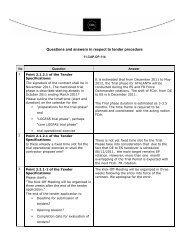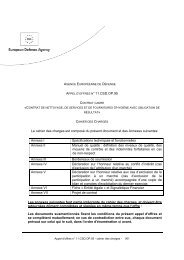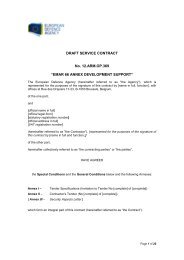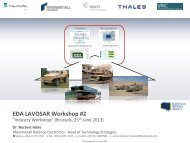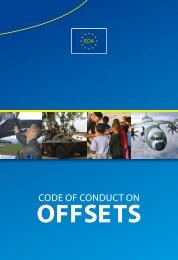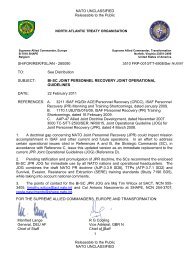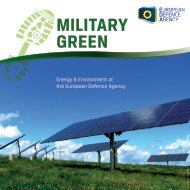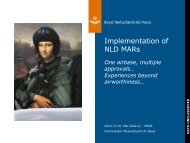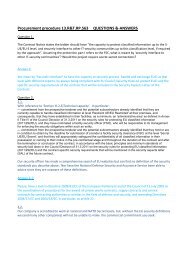capability development plan - European Defence Agency - Europa
capability development plan - European Defence Agency - Europa
capability development plan - European Defence Agency - Europa
Create successful ePaper yourself
Turn your PDF publications into a flip-book with our unique Google optimized e-Paper software.
IMPACT OF SCIENCE AND TECHNOLOGY ON FUTURE<br />
CAPABILITIES DEVELOPMENT<br />
Elsag Datamat - Cryptography laboratory © Finmeccanica<br />
MBTs.<br />
Protection of land vehicles and their personnel, for example against IEDs at close range, will therefore<br />
to a large extent remain a question of tactics and force posture. S&T contribution in terms of sensors<br />
and networks, appropriately used together with tactics to assist in situational awareness, are likely to<br />
provide more promise in order to reduce overall vulnerability than passive or active protection<br />
measures. Overall, a multi-pronged approach will therefore be needed.<br />
Other issues with land vehicles include on-board sensors (discussed under knowledge), weapons<br />
(discussed below) and power sources and propulsion.<br />
In the area of power sources and propulsion, no fundamental breakthrough is foreseen. The civilian<br />
sector is leading <strong>development</strong>s with respect to new fuels and hybrid solutions, which are driven by<br />
environmental concerns. Such <strong>development</strong>s are not expected to provide any new capabilities as such<br />
to the military sector, but may be needed in order to conform to environmental standards or fuel<br />
availability. The military may however very well be the last user of conventional fuels given the long life<br />
cycle of platforms. There is the risk that such <strong>development</strong>s could increase the logistical footprint of<br />
future forces, if they need to run on specialty fuels not available in-theatre.<br />
Aerial platforms. The main S&T-related issues relevant to aerial platforms are their role in air-to-ground<br />
operations, both for ISTAR purposes and as weapon carriers, and their protection against groundbased<br />
threats. Developments in the aerial platforms area, relevant to this purpose and made possible<br />
by technological <strong>development</strong>s include:<br />
- Increased use of UAVs, small and large, both as reconnaissance and weapon platforms;<br />
- Increased use of stealth technologies for both manned and unmanned aerial platforms to enhance<br />
their survivability against ground-based threats;<br />
- The use of improved sensors against ground targets.<br />
ISTAR by aerial platforms against ground targets will become enhanced by means of <strong>development</strong>s in<br />
both the radar and electro-optic area. Electro-optic sensors will develop towards higher resolution<br />
(alternatively allowing detection of a certain target at higher range), better possibilities of penetrating<br />
camouflage by using a broader part of the wavelength spectrum and the introduction of laser sensors<br />
(so-called Lidar).<br />
Synthetic aperture radars (SAR) will allow higher resolution, better discrimination between different<br />
types of targets, have improved all weather surveillance <strong>capability</strong>, will be capable foliage penetration<br />
and will be effective against many camouflaged and certain underground targets.<br />
Small unmanned platforms will increasingly be able to carry both electro-optic and radar sensors due<br />
to the reduced size, weight and power requirements of the latter. The most advanced radars, including<br />
the most advanced SAR equipment will however require specially adapted and geo-referenced<br />
platforms, rather than being integrated on any (multi-purpose) aerial platform or smaller UAVs.<br />
Sensor <strong>development</strong>s will make such sensors increasingly multifunctional (i.e., appropriate against<br />
several types of targets and adaptable to various environments) and allow appropriately equipped<br />
aerial platforms to use passive receiving modes, which will enhance stealth.<br />
Increased use of NEC will allow the <strong>plan</strong>ning and decision cycle for engaging ground targets with airlaunched<br />
weapons to be shortened.<br />
Situational awareness by means of networked sensors will lead to improved Next Generation<br />
Identification Friend or Foe (NGIFF)/Combat ID in air-to-ground engagements, reducing the risk of<br />
fratricide.<br />
It may still be possible for adversaries’ to hide from airborne sensors and weapons to some extent, but<br />
for less advanced adversaries, it will require more effort to do so, and such efforts will reduce their<br />
efficiency. More technologically advanced adversaries may be able to field countermeasures, wage<br />
45<br />
FUTURE TRENDS FROM THE CAPABILITY DEVELOPMENT PLAN




